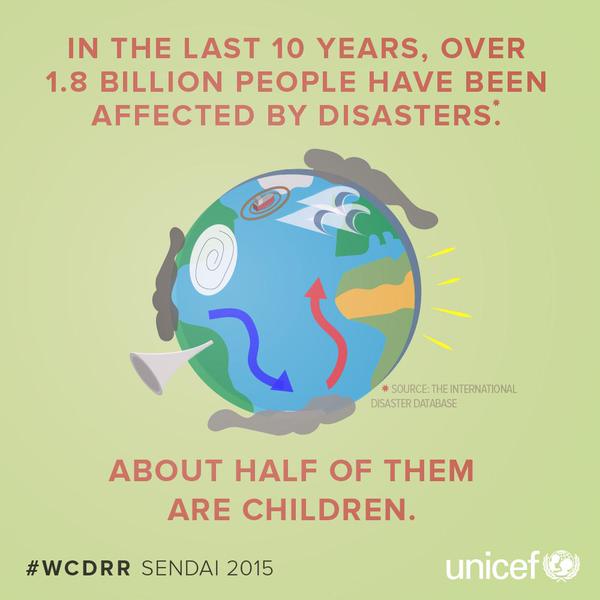UN Secretary General Ban Ki-Moon, speaking at the Third World Conference on Disaster Risk Reduction (WCDRR) in Sendai, Japan, yesterday emphasized the need to “embed Disaster Risk Reduction into the very DNA of our sustainable development framework.”
“Sustainability starts in Sendai,” he said. “Disaster Risk Reduction can be a front line against climate change.”
Ten years after the India Ocean Tsunami and the implementation of Hyogo Framework for Action, the WCDRR kicks off an ambitious 2015 agenda which includes: July’s third high level conference on global finances and sustainable development in Addis Ababa, Ethiopia; the September UN Special Summit to implement the Sustainable Development Goals as part of the Post-2015 Agenda; and the December UN Climate Talks (COP21), where world leaders have committed to reaching an international agreement in curtailing GHG emissions by 2020.
The WCDRR, which concludes Wednesday, brings together representatives from governments, NGOs, and civil society to produce an ambitious Global Framework on Disaster Risk Reduction (DRR). Reports from the conference show a keen understanding of the need for an all inclusive response to disasters, one which engages, youth, people with disabiities and that insures that communities are actively engaged in and understand DRR projects.
“Development, if done well, and if it looks at the hazards to understand who is vulnerable and how, is good DRR,” writes UNICEF Connect’s Anthony Spalton. “It can lift people out of poverty, give them a voice and move them from harm’s way. But gains can be fragile and we must protect them.
Why DRR
Reports from international agencies and scientists reveal a daunting picture of the impacts of severe weather events.
• In the last 10 years, over 1.8 billion people have been impacted by disasters. About half of them are children (UNICEF)
• Disasters have a major impact on children and their education: Most schools are poorly constructed and cannot withstand a disaster; 1.2 billion children are enrolled in primary and secondary schools worldwide and 3 out of 4 live in areas with high seismic activity
(Plan
•Natural Disasters are the leading cause of hunger
•Poor, drought prone countries lack access to DRR funding (Global Resilience)
•By 2030, up to 325m extremely poor people will be living in the 49 most hazard-prone countries (UNICEF)
Focus on Global Health Resilience in DRR
The World Health Organization has campaigned successfully to ensure that protecting people’s health is front and center in the emerging framework.
“In the 10 years since Hyogo, governments have increasingly recognized that healthy people are resilient people, and that resilient people recover much more quickly from emergencies and disasters,” says Dr Bruce Aylward, WHOs Assistant Director-General for Emergencies. “Recent and ongoing disasters – from Typhoon Haiyan in the Philippines to the Ebola crisis in West Africa – highlight the centrality of human health to our collective goals in disaster risk reduction by all sectors.”
Youth Involvement in DRR

Y[dropcap1]L[/dropcap1]outh are highly visible participants at WCDRR. Speakers at today’s Children & Youth Forum stressed the valuable contribution of youth as policy makers, volunteers, first responders and mobilizers.
The urgency of educating youth in life saving skills was most dramatically expressed in discussions of projects where volunteers teach kids how to swim to survive floods.
In Bangladesh, for example, where 18,000 children drown each year due to extreme Monsoon flooding UNICEF supports a local SwimSafe program for kids.
SwimSafe’s programme recruits and trains Community Swimming Instructors (CSI) to teach children aged 4 to 10 swimming and survival skills. Through a 21-step process, children are taught to be confident in the water, to develop the ability to float and swim, and how to rescue somebody who is drowning. They are also taught to identify life-threatening water hazards, explains Sakander Ali, CIPRB Field Manager at the Amin Bazaar pool, one of four portable swimming pools in Dhaka. Drowning claims the lives of thousands of children in Bangladesh every year, but a UNICEF-supported programme aims to prevent drowning deaths by teaching children to swim.
“We have very limited window this year to realize all these very important priorities,” the Secretary-General says. “Yet all these series of conferences are interlinked.” We have very limited window this year to realize all these very important priorities,” the Secretary-General says. “Yet all these series of conferences are interlinked.”


